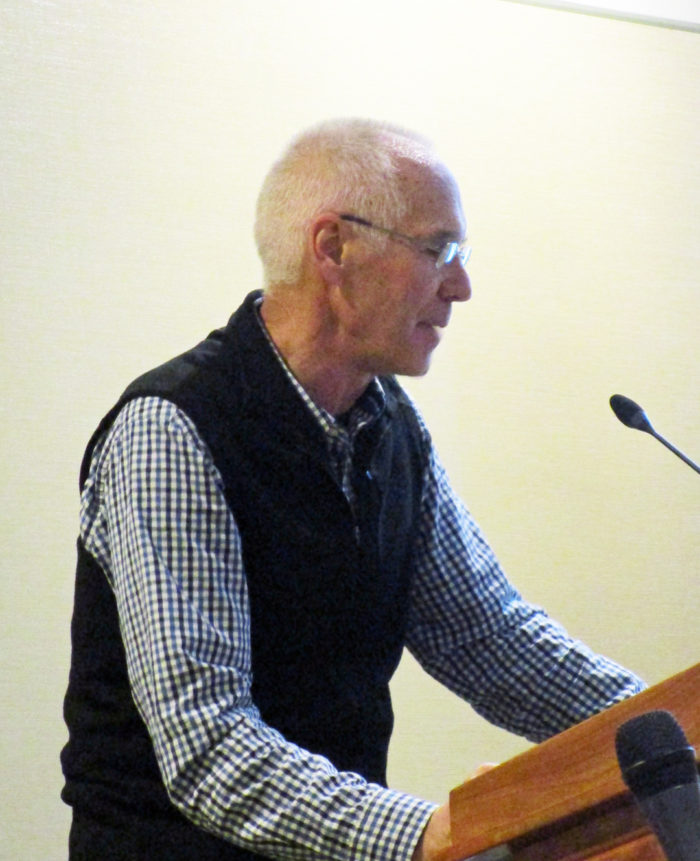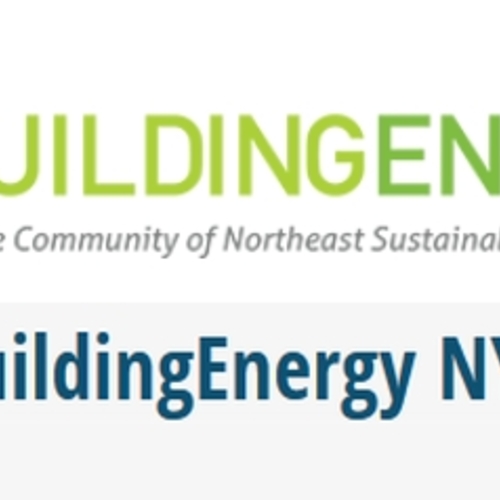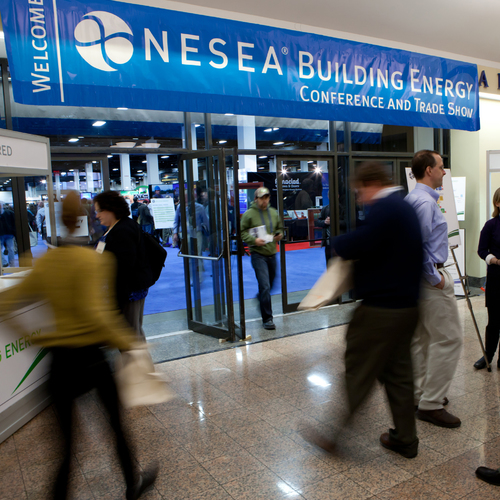
Image Credit: All photos: Martin Holladay
BuildingEnergy, the annual conference sponsored by the Northeast Sustainable Energy Association (NESEA), recently concluded in Boston. As usual, the NESEA conference was a great way to catch up with friends and to soak up information offered by some of the smartest scientists, engineers, designers, and builders in the country.
Here are notes from some of the presentations.
Net-zero isn’t enough
The first session I attended was a panel discussion focusing on the embodied energy, environmental effects, and human health effects of building materials.
Jack Armstrong, chemical engineer: “It’s not enough to be net-zero-energy or even net-positive. Every product has a lot of components. These materials all have embodied energy and ingredient concerns — for example, flame retardants in foams. With LEED Version 4, we are starting to ask, ‘What about the materials? What about off-gassing?’”
Bruce King, structural engineer and straw-bale expert: “If you finish a building this year, the entire carbon hit from the construction happens immediately, beginning on the first day it is occupied. There is no operating energy yet. It takes 15 years for the rising operating energy line to cross the descending line from annual energy hit from the embodied energy of construction. When it comes to addressing climate change, though, now is when we need to make a difference. When you add a lot of solar panels and extra insulation to a project, you are adding a lot of embodied energy up front.”
Greg Norris from the International Living Future Institute: “The real impacts of a building are larger than those we usually consider. What’s true for embodied energy is also true for eutrophication, biodiversity, child labor, and human rights abuses. So we all have these multi-dimensional footprints. You cannot drive your footprint to zero. … Net…
Weekly Newsletter
Get building science and energy efficiency advice, plus special offers, in your inbox.

This article is only available to GBA Prime Members
Sign up for a free trial and get instant access to this article as well as GBA’s complete library of premium articles and construction details.
Start Free TrialAlready a member? Log in















8 Comments
More reports
Thanks for your updates. I know you were stuck in traffic for the opening plenary on the electrical grid, but it was fascinating. I missed the first part for the same reason, so i'll hope someone who saw the whole thing weighs in. My takeaway was that there are some tremendous opportunities there for the grid to move power in and out of people's homes - to essentially use homes as smart devices to store power and reduce peak demand. There are some worrisome privacy issues attached to it for me, but it was exciting and hopeful.
I went to Robb ALdrich's session just before yours - he and Paul Francisco (of Univ. Illinois) discussed ventilation. As with previous sessions at various venues on this topic, what stuck with me was how little we know about the topic. We don't know what to measure or how to measure it.
Paul shared a relatively small study (84 homes) that seemed to show that retrofitted homes with balanced ventilation provided more healthy results than homes with exhaust-only ventilation, but the results weren't overwhelming.
Robb showed the initial costs and operational costs of exhaust only, supply only, and balanced. Not surprisingly, exhaust only is by far the cheapest on both measures.
I'm very grateful that people like them are researching this, because I have very little confidence that my methods have much science behind them right now.
Byggmeister and South Mountain (both of MA, both central companies in NESEA's history) presented some fascinating work they've been doing on foot printing. For Byggmeister, it was looking at some big renovations they'd done, and for South Mountain it was their own internal operations. I know they both are or will be sharing those results at some point so I won't bother going into detail. (you can download SMC's Phase 1 report here - http://www.southmountain.com/downloads/14-04-23_Footprint_Report_Final.pdf)
I also went to a terrific session in the morning (full disclosure - I helped organize it). Rachel Wagner, of WagnerZaun in Duluth) did a great session answering the question Has high performance made solar design irrelevant? Not surprisingly her answer is NO! It's very hard to design a session that has "basic" material but is also challenging but I thought Rachel did so very well. She makes a compelling argument for using an integrated design approach and not, as she put it, slapping passive solar "on as an afterthought." "It's not rocket science, but it is science" was my favorite line of hers.
For those of you who didn't make it, I can't recommend it strongly enough for next year. It's made an immeasurable difference in how I approach building, and many of the people I admire most are active members of NESEA. Planning for BE16 has already begun, so let NESEA know if there are subjects you want to know more (or less) about.
Response to Dan Kolbert
Dan,
Feedback for next year's conference: How about holding the conference somewhere else besides downtown Boston? I woke up at 4:00 a.m., but still spent over an hour in bumper-to-bumper traffic on I-93. When I finally got off the interstate, I discovered that last year's parking lot has been replaced by a new skyscraper, now under construction, and I spent another half hour driving in circles looking for a parking lot without a "Lot full" sign. Made me grateful to live in Vermont.
Thanks for sharing information on the sessions I missed. (It's always hard to choose between two or three compelling presentations that occur simultaneously.) Fortunately, I got a chance to catch up with Rachel Wagner, who graciously gave me a summary of her presentation. I wish I could have attended.
If any GBA readers want to know more about the efforts of the South Mountain Company to track their carbon footprint, they can read John Abrams' report here on GBA. We published it last June: Tracking Our Company’s Carbon Footprint.
too many things to do
While the content and thrust sounded interesting, I traditionally
had trouble with both the location [expensive parking if you can
find it] and the sheer concurrency of how it was organized. As
noted by others, too many conflicting events that seemed interesting,
even with the efforts to "de-track" the conference this time.
I didn't even go in to slum in the trade-show this year; I figure
in another couple of months all the presentation slide decks will
be online and I can just catch up from those.
BTW -- in a pinch, try the "Channelside" parking right off A
street. It's a little cheaper, large, and staffed 24x7 by an
actual HUMAN who is happy to accept cash on exit. It's just a
little farther away from everything, but the longer hike gets
you the leg workout to complement the arm/shoulder workout we
all got this winter.
_H*
context for comments
Martin, thank you for providing those of us who haven't yet learned omnipresence some great quotes from sessions we missed.
To add back in a little context that your quote on FSC and SFI forestry standards removes, I also talked about how SFI has come a long way from its roots in industry. It is now a third-party label with an auditing process that is separate from its standards-writing process. It does remain closely tied to the timber industry, and less rigorous than FSC. For more depth, see my full report here:
http://www2.buildinggreen.com/article/certified-wood-how-sfi-compares-fsc
Response to Tristan Roberts
Tristan,
Thanks for your comments; they help ensure that readers understand the context of your words. And I appreciate the link to your report.
Response to Dan Kolbert (Comment #1)
Dan,
Paul Francisco, a research engineer at the University of Illinois at Urbana-Champaign, asked me to post this response to your comment:
"There was a post on your GBA blog about my presentation at NESEA, but the post got some facts wrong. It said that our study compared balanced [ventilation] to exhaust-only, and that balanced looked better. That is not correct.
"We did two groups, one that followed 62-1989 (BTL/MVR/BAS etc.) and one that followed 62.2-2010. None of the 62-1989 homes got any mechanical ventilation added because the remaining leakage was always enough that it was not required. All of the 62.2-2010 homes got exhaust-only mechanical ventilation at the rate required by 62.2. So, there were no balanced systems at all."
-- Paul W. Francisco
Roberts comment on Airkrete
Roberts: “What about Air Krete? It’s an inorganic-mineral based insulation. It should be low-toxicity. But it is friable. You have to blow it into a cavity or an attic. The manufacturer has recently reformulated Air Krete, and they say it is R-6 per inch…” [At this point John Straube makes a loud stage-sneeze, a sneeze that is vocalized as “Bullshit.”] “… but the company uses a different method of calculating R-value than the one used by every other manufacturer — the one required by the FTC.” - See more at: https://www.greenbuildingadvisor.com/articles/dept/musings/nesea-conference-highlights#sthash.AtlbLA5k.dpuf
Interesting reading this. We have AirKrete installed in our 1925 house and WERE happy with it until I got educated through GBA on insulation materials, vapor barriers, air barriers, air sealing and all that jazz... We have a PROBLEM and get so far nothing from the installer. Waiting on answers from Bill Szabo of AirKrete Inc. who is taking his sweet time. Wanting to TALK on the phone as he was a two finger typist... I fear that they see the problems but do not want to put it in writing. We are switching to Rock Wool. AirKrete is unnecessarily complex and fragile is our experience. RockWool and Airkrete are both permeable. Why use AirKrete??
May start a new blog on this when all is resolved or will remain unresolved... As THIS blog is not the place... (Martin or administrator can move this..)
BIG WARNING, Airkrete can not be installed in any OPEN space, like an open attic floor. Airkrete must be installed in a 6 sided enclosed cavity. Says Bill Szabo, vice president of Airkrete Inc. Now their website shows open attic installs. What?? We have cracks the size of the Grand Canyon in our attic install. All the way to the drywall. Plus cracked loose off the rafters.
Will keep you posted.... Not a fan anymore of AirKrete...
Jan
To Paul
Thanks - I actually re-read my notes last night and realized I had been describing the study wrong. It was great to hear about, and I'm very glad that the studies are being done - I look forward to some day having some good data to make decisions with.
Log in or become a member to post a comment.
Sign up Log in